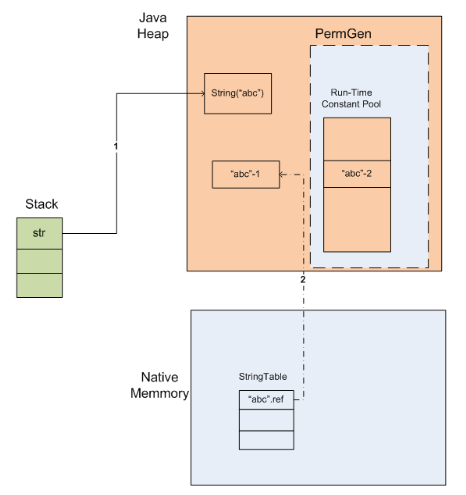# 不可变性
- String为不可变对象,即一旦对象被创建初始化后,内部的状态数据就会保持不变
- 对字符串的修改,实际上只是内存地址引用的修改(返回新创建的字符串的引用)
String str = "Hello "; // "Hello "开辟一次空间
str += "World"; // “World"开辟一次空间,"Hello World"开辟一次空间
str += "!"; // "!"开辟一次空间,"Hello World!"开辟一次空间
// 总共开辟了5次空间,产生很多垃圾
1
2
3
4
2
3
4
# 字符串常量池
字符串常量池是由 JVM 通过 C,C++ 编写的 StringTable 来实现的
StringTable 本质就是一个哈希表,StringTable 自身存储在本地内存(native memory)中,value 存储的是字符串对象的引用(非字符串对象本身)
通过实验 (opens new window),JDK1.6 前,字符串对象本身存储在永久代中,JDK1.7 及以后,转移存储在 JVM 堆中

class Demo {
public static void main(String[] args) {
String s1 = "Hello";
String s2 = "He" + "llo";
String s3 = "He" + new String("llo");
String s4 = new String("Hello");
String s5 = s4.intern();
String s6 = "He";
String s7 = "llo";
String s8 = s6 + s7;
/*
s1 == s2 // 编译器优化存在
s1 != s3 // 拼接创建了新的字符串对象
s1 != s4
s1 == s5 // Hello已经在池中直接返回池中存储的引用
s1 != s8 // 编译器不会优化,拼接创建了新的字符串
*/
}
}
1
2
3
4
5
6
7
8
9
10
11
12
13
14
15
16
17
18
19
20
2
3
4
5
6
7
8
9
10
11
12
13
14
15
16
17
18
19
20
字面量创建字符串
- Hello 作为字面量,开始存储在 .class 文件常量池中
- 当 Demo 类加载时,会在 Heap 中创建一个 Hello 对象,同时在 StringTable 中存放一个它的引用
- 主线程运行,Stack 中创建 str 变量,JVM 去字符串池中寻找 equals("Hello") 的字符串是否存在
- 发现存在,则从字符串池中获取 Hello 的引用,并赋值给 str
- 如果发现不存在,则在 Heap 中新建 Hello 对象,将引用驻留(intern)在字符串池中,并赋值给 str
使用 new 关键字创建字符串
- 前面类加载的过程都是类似的,只是在运行时,无论字符串池中是否有值相等的对象,都会在 Heap 中开辟一块内存,创建新对象
new String("123")实际创建了两个字符串对象,“123”会创建一个字符串对象驻留常量池
字符串拼接
- String 类重载了
+,+=,可以用于字符串拼接 String s = "a" + "bc";,字面量字符串拼接,编译器会直接优化Stirng s = s1 + s2;,其底层实现是new StringBuilder().append(s1).append(s2).toString()
手动入池
String s1 = new String("Hello"); String s2 = s1.intern()可以将字符串手动入池- 如果字符串池中本身存在 equals(s1) 的字符串,则返回池中的字符串对象引用
- 如果字符串池中不存在,考虑不同版本的情况
- JDK1.6 以前:由于字符串池引用的字符串对象本身存在永久代,因此会在永久代创建 equals(s1) 的字符串,池中存放其引用,并将引用返回
- JDK1.7 后:此时字符串池引用的字符串对象本身存储在 Heap,不再 Heap 中重复创建 equals(s1) 的字符串对象,而是将 s1 的引用直接存放进池中,并返回该引用
public static void main(String[] args) {
String s1 = new String("1") + new String("1");
s1.intern();
String s2 = "11";
System.out.println(s1 == s2);
// JDK1.6 false
// JDK1.7+ true
String s3 = new String("a"); // 这里其实已经创建一个 "a" 入池了
s3.intern();
String s4 = "a";
System.out.println(s3 == s4);
// JDK1.6 false
// JDK1.7+ false
}
1
2
3
4
5
6
7
8
9
10
11
12
13
14
15
2
3
4
5
6
7
8
9
10
11
12
13
14
15
理解Java字符串常量池与intern()方法 (opens new window)
# 方法API
# 类型转换
/**** char ****/
String str = String.valueOf(char ch);
String str = String.valueOf(char[] ch);
char ch = str.charAt(int idx);
char[] ch = str.toCharArray();
/**** int ****/
String str = String.valueOf(int num); // best
String str = "" + num;
int num = Integer.parseInt(str);
1
2
3
4
5
6
7
8
9
10
11
12
2
3
4
5
6
7
8
9
10
11
12
# 常用操作
str.length(); // length of string
/******** Truncate ********/
str.substring(i, j) // return [i .. j-1]
str.substring(k) // return [k…end-1]
/******** Transform ********/
str.toUpperCase() // change to upper case
str.toLowerCase() // change to lower case
str.replaceAll(str1, str2) // replace str1 with str2 (str1 can be regex)
str.replaceFirst(str1, str2) // only replace first shows up
str.replace(oldCh, newCh) // replace for character
str.trim() // remove leading and trailing space
str.split(regex) // return String[]
str.split(regex, int limit) // limit: the result threshold
// escape character 转义字符
// "." -> "\\." "|" -> "\\|"
/******** Compare ********/
str.equals(str) // check for content equal, do not use ==
str.equalsIgnoreCase(str)
str.compareTo(str2) // 0: euqal; >0: str > str2; <0: str < str2
str.compareToIgnoreCase(str2)
/******** Search ********/
str.indexOf(str) // return idx where str first show up, else -1
str.contains(str) // return indexOf(str) >= 0
str.startsWith(str) // check whether the str starts with str
str.endsWith(str) // check whether the str ends with str
1
2
3
4
5
6
7
8
9
10
11
12
13
14
15
16
17
18
19
20
21
22
23
24
25
26
27
28
29
30
31
2
3
4
5
6
7
8
9
10
11
12
13
14
15
16
17
18
19
20
21
22
23
24
25
26
27
28
29
30
31